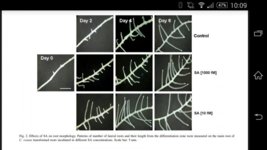I suspect that this popular narrative about aspirin as a root stimulant results from a conflation of the understanding of willow tea, salicylic acid found in willow bark, and acetyl salicylic acid (or aspirin). From what I can gather, the marginally effective root stimulant in willow tea, made from soaking cut willow stems in water, is indole butyric acid, and not the salicylic acid found in willow bark. So aspirin is off base. Aspirin does slow wilting of cut flowers, when added to the vase water, apparently by suppressing ethylene production, but that's not relevant to growing tobacco.
http://www.hobbyfarms.com/crops-and-gardening/transplanting-root-stimulants.aspx
http://www.ehow.com/how_6566732_homemade-starter-solution-plant-cuttings.html
Google searches on root stimulants are polluted with commercial products and copy-paste myths. So I would suggest caution when considering applying widely circulated gardener myths to your tobacco plants.
Bob
I searched the Science Direct Database and in short time was presented with a myriad of peer reviewed studies that either studied salicylic acid and plant growth specifically, or used previous research findings as a part of a larger theory or related hypothesis. It is overwhelmingly clear that salicylic acid promotes root growth. There are all kinds of other benefits that have been studied as well. For example salt stress on tobacco plants. Here are some excerpts.
Plant Physiology and Biochemistry vol.45 (2007) p501-507
Responses of transformed Catharanthus roseus roots to femtomolar concentrations of salicylic acid
Ileana Echevarrı-Machado, Rosa Marıa Escobedo-G.M., Alfonso Larque-Saavedra
1. Introduction
Salicylic or ortho-hydroxybenzoic acid (SA) is considered a plant growth regulator due to its effects on plant physiology [21]. One reported early effect of SA in plants is rooting induction in the detached root stocks of ornamentals, or in bean plant cuttings treated with this chemical [2,15,16,23]. Similarly, spraying of SA on to soybean plants shoots resulted in significantly higher root growth: 113% greater than a control [13]. Lower SA dosages regulate growth in other plant species [27], though the underlying mechanism by which spray application of SA onto the aerial portions of plants affects root growth is still unclear. Previous research also indicates that SA at picomolar concentration has significant stimulating effects on cellular growth and in vitro somatic embryogenesis of Coffea arabica [20]. The aim of the present study was to determine the sensitivity of Catharanthus roseus transformed root cultures to SA, and if picomolar or lower SA concentrations affect root growth and development when applied directly to roots grown in vitro. This root culture system is remarkable for its fast, hormone-independent growth, lack of geotropism, high lateral root branching and genetic stability. These features help in studying the simultaneous effects of exogenous compounds on various meristematic centers.
4. Conclusion
The present and previous results from this laboratory indicate that SA has a significant effect on root growth and that roots are highly sensitive to this compound. Future research needs to focus on evaluating changes in hormonal contents (auxin, CK and ethylene) in the different root tissues in the presence of SA, and on identifying the molecular and biochemical nature of these effects. The fact that femtomolar SA concentrations affected root growth in the bioassay system used here should also be addressed since it may prove to be a new way of determining the ability of plant growth hormones to affect physiological process.
Effects of salicylic acid on the growth of roots and shoots in soybean
Original Research Article
Plant Physiology and Biochemistry, Volume 36, Issue 8, August 1998, Pages 563-565
Marco Antonio Gutiérrez-Coronado, Carlos Trejo-López, Alfonso Larqué-Saavedra
Abstract
Aqueous solutions of SA, applied as a spray to the shoots of soybean (Glycine max (L.) Merr. cv. Cajeme), significantly increased the growth of shoots and roots as measured after seven days of treatment. Shoot spraying of SA had no significant effect on photosynthetic rate. Growth increases were obtained in plants cultivated either in the greenhouse or in the field; SA-induced increases in root growth of up to 100% were measured in the field.
Environmental and Experimental Botany vol.114 (2015) p117–128
Magical mystery tour: Salicylic acid signalling
Martin Jandaa,b, Eric Ruellandc
SA is a very important phytohormone. It regulates many physiological processes, such as cell growth, respiration, stomatal aperture, senescence, seed germination, seedling development and thermo-tolerance (Boatwright and Pajerowska-Mukhtar, 2013; Vlot et al., 2009). SA has a role in plant responses to many abiotic stresses such as chilling, heat, heavy metal toxicity, drought, osmotic stress and salinity (Horvath et al., 2007; Vicente and Plasencia, 2011). It also has a crucial role in plant pathogen response. The first mention of SA playing a role in plant defence was in 1979 (White, 1979). In 1990, two important studies described SA as a key component of Systemic Acquired Resistance (SAR); a mechanism by which plants gain a long-lasting protection against a broad spectrum of pathogens at sites distant from that of the initial pathogen attack (Malamy et al., 1990; Metraux et al., 1990). SAR is associated with the induction of Pathogenesis Related (PR) genes, which contribute to the resistance. PR genes are induced in both local and systemic tissues (non-infected tissue). Priming of plant defence conferred by SAR can persist for weeks to months, and possibly even over the whole growing season (Durrant and Dong, 2004).


